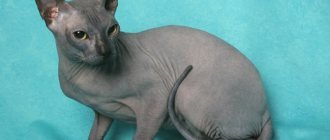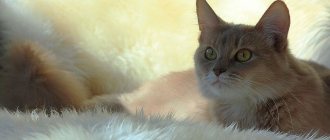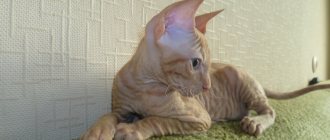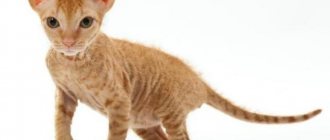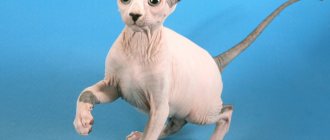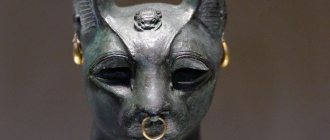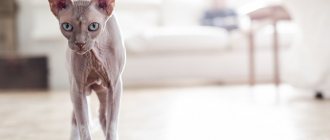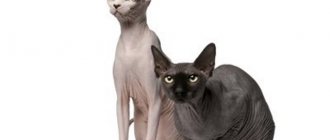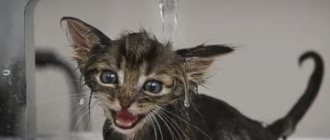Features and habits of the Sphynx Brush cat
Cats without hair are no longer considered a novelty, and it is no longer possible to surprise with them. Modern breeds of such cats make many people smile and want to touch their skin and stroke them. The Sphynx Brush is a cat with little fur on its body - the hair is short and sparse, more like fluff.
Don Sphynx brush.
Types of curly cats
The rex gene (Re) often appears in both outbred and purebred animals. Cats with curled fur have appeared periodically in different parts of the world. But initially they only caused surprise and things did not come to further breeding. Only since the mid-20th century have owners of mutant cats pushed felinologists to breed new breeds.
The three most famous types of cats with the rex mutation are Devon Rex, Cornish Rex, and Selkirk Rex.
Devons and Cornish appeared almost at the same time - in the 1950s, in England. The Selkirk Rex is another American line that can be traced back to 1987. In Devons and Cornish the mutation has a recessive gene. This means that they can give birth to kittens, including those with straight hair. The rex gene in the Selkirk Rex is dominant, which means all kittens in the litter will have curls.
Cornish Rex
The first kitten with mutated fur was discovered in Cornwall (England) in 1950. An ordinary cat gave birth to at least a strange baby: a narrow head, long legs and tail, huge bat-like ears, astrakhan fur. He could not help but interest the breeders.
The cat was crossed with its mother, and 2 more curly-haired kittens were born. They were named Rex. Translated, this word means “royal”. In fact, this was the name of a breed of rabbits with slightly wavy and thick fur. Therefore, all rexes owe their name not to kings, but to rabbits.
From these Cornish Rexes the Cornish Rex breed was created, officially recognized in 1967.
In animals, the outer hair is very thin and crimped, almost indistinguishable from the undercoat. The whole body is covered with waves of tight curls; the tail has increased waviness (see photo). The curls are wavy and the ends are directed towards the skin (closed type of curl). Cornish wool is compared to satin, astrakhan fur, velvet, and rabbit fur. Even the whiskers of these cats are also curled.
Devon Rex
Devon rexes, like Cornish cats, come from England (Devonshire County), but have their own rex gene. Devonshires have curls directed in different directions. The rings of fur may be tight or run in the form of slight ripples along the animal's body. Cats with curls behind the ears are highly prized. The Devon's coat is similar to that of a sheep or poodle. The vibrissae are very short and strongly curled, so that they seem to be absent at all.
The first curly-haired kitten was born in 1959 from an ordinary cat and received the nickname Kirli, which means “curly.” The owner decided that this was a well-known Cornish Rex breed and decided to start breeding it. Kirley was crossed with a Cornish cat, but the result was normal kittens. It became clear that the Kirley mutation was different, different from the Cornish one. Kirley is the founder of the entire Devonshire Rex breed line. When Devons are crossed with other curly breeds, regular kittens are also born.
A distinctive feature of girls is their friendly character and social adaptability. And of course, an extraordinary appearance - a flat head, huge ears, big eyes and an upturned nose. All this creates an alien image. Devon Rexes quickly became popular and since 2014 have been included in the 15 most popular breeds in Europe and the USA. Devon Rexes are also included in the list of the smallest cat breeds in the world.
What does the Don Sphynx look like?
After looking at the photo of the Don Sphynx, one gets the impression that he has a lot in common with Egyptian cats. The size of representatives of this breed reaches 25-30 cm in height at the withers. How much a Donchak should weigh depends on gender - boys are always larger. They reach 5-7 kg. The weight of girls is more modest and amounts to 3.5-5 kg.
Muzzle
The breed is characterized by a wedge-shaped head with pronounced cheekbones and a strong-willed chin. On the rounded muzzle there is a straight nose, connected to the wrinkled forehead by a pronounced stop. On the top of the head are large, widely set ears, rounded at the tips.
The Donchak has slightly slanted, almond-shaped eyes that lack eyelashes. Short vibrissae are twisted into a spiral. They often break off, and sometimes they don’t grow back at all. Defects of the breed include a narrow or rounded head, too small ears, inversion of the eyelids and an underbite of more than 2 mm.
Body type
The low and thin neck goes into a dense and muscular body, expanding in the croup and chest. The front limbs of the Doncha are shorter than the hind limbs. They end in strong and powerful paws with elongated toes. The flexible, whip-like tail tapers to a tip. An abundance of folds is characteristic of the neck, armpits, paws, abdomen, groin area and tail.
Skin and color
The elastic skin of the Don people is completely bald or covered with soft down. Depending on the type and structure of the existing fur, there are 4 varieties of the Don Sphynx:
- Brush
. The most unusual species with sparse curly fur. The length of its hairs is the maximum. Such animals are not allowed for exhibitions, but are used for breeding. With age, the number of curly hairs decreases. - Flock
. The body is covered with “peach fuzz”, which gradually disappears. - Velor
. Unlike flocks, the fluff of a velor cat is longer and thicker. It also disappears as they grow older, but sometimes the coarsest hairs remain on the head and paws. - Hollowborn
. The fur is completely absent. The skin is covered with many wrinkles and is slightly sticky to the touch due to a special secretion. It is secreted by the sebaceous glands to protect against infections.
Among the colors of the Don Sphynx, any colors are allowed except lilac and chocolate. Due to the lack of fur, these cats rarely cause allergies in people.
Skin and coat types of sphinxes
Only 4 types of sphinxes fit the description of hairless cats. The first of these to appear were representatives of the Canadian breed, whose targeted selection began in 1960. Although the name of these sphinxes cemented their affiliation with the Country of the Maple Leaf, the main experiments were carried out in the United States.
The mutation that led to the hair loss occurred naturally for unknown reasons. The Canadian Sphynx is born with fur, and then carries residual signs of it throughout its life. He only looks completely naked from afar. In fact, the thick skin is covered with fluff (up to 2 mm), and there is short hair on the bridge of the nose. Hair growth is also allowed on the inside of the ears, between the toes, on the belly and tail. To the touch, the skin of the Canadian Sphynx gives the impression of velor or velvet pile - an almost imperceptible gentle coating.
“Canadians” are born in this form and no significant transformations occur to them throughout their lives.
Another branch is the Don Sphynx, which was bred in Russia 20 years later. The hairlessness of this breed is due to a mutation of completely different genes and, although externally similar to the Canadian Sphynx, the domestic species has significant differences:
- there are Don Sphynxes with fur;
- As cats of this breed grow older, their external signs change.
Important! It is by the condition of the skin and the presence of overgrowth that experts can distinguish between these groups of cats. Moreover, this applies to all representatives, which also include Ukrainian Levkoys and Peterbalds (St. Petersburg sphinxes).
Hulborn
Such sphinxes have had no hair since childhood. Kittens of the Canadian breed may also have this sign, but later the body becomes covered with fluff. And the Don remain naked for the rest of their lives.
Naked with whiskers and eyebrows
The second type of naked-born. They can be born with no facial hair at all, or they can have mustaches and eyebrows. This sign is typical only for this group, and in all other cases, “woolen” sphinxes demonstrate all the signs that are provided for in the breed standard.
Flock
Rare wool that fits very tightly to the body. From a distance it is not even visible, but from a close distance it becomes noticeable. The faint fluffy coating on the skin feels like a delicate red dusting, like on peach fruits. Flock cats are often called velor cats, although in fact they are two different groups.
Sphinx velor
Externally, velor Sphynx cats are very similar to flock cats, but upon closer inspection and to the touch they are completely different. The fur of velor sphinxes is longer and thicker, but it lies tightly on the body and is therefore not visible at all. Depending on the color, this visual illusion behaves differently. The black velor Sphynx seems completely naked, but if you run your finger against the fur, you can feel the obvious resistance of the hair.
Soft brush
The description of the appearance of the Sphynx Brush breed may vary depending on which animal is in mind. The coat of Sphynx cats from this group is soft and slightly wavy.
Hard brush
The second group in the description of brush sphinxes has more elastic and springy hair. It curls and looks like lamb's wool. Grows longer than the coat of a soft brush.
Straight-haired
There are also very unusual sphinxes with fur. In terms of the quality of their coat, they are very similar to shorthaired cats. This species lingered in the group of hairless cats for the only reason - experts still haven’t figured out the mechanics of genetic mutation. Overgrown Sphynx cats with fur carry a mixed “cocktail” of traits that in the next generations can give rise to full-fledged rubber, flock, velor or brush kittens.
pros
Many owners note the friendly and easy-going nature of Sphynx cats with fur. Cats of this breed have the following advantages:
- lack of aggression;
- high intelligence;
- learning ability;
- good harmony with other species of animals;
- pickiness in food;
- cleanliness.
In addition, Sphynx cats with fur are considered healing cats. They have increased heat exchange, and the surface of the hair always remains hot. These animals can be used as living heating pads. They are extremely affectionate and love to cuddle up to the human body.
Reviews
All owners of such tailed animals are very happy with them, it is impossible not to fall in love with them; as a rule, such pets become loved by all family members, even if someone is initially put off by their appearance. Cats of this variety are disciplined, easy to train and raise, and love to be photographed.
They are loyal and love their owners, meeting them at the doorstep and following them around the house everywhere. They often sleep in bed with people, love to purr on their knees and sleep in the warmth of human hugs.
Some take in adult animals, and they still quickly adapt to the new environment. They love children and easily find a common language with other representatives of the animal world. They do not spoil wallpaper and furniture, especially if you accustom them to scratching posts from childhood. They always go to the toilet in the litter box. The only thing that can be a problem for busy people is daily wiping, but for those who are already used to it, caring for a cat is a pleasure.
Flock
Newborn kittens may appear hairless. But upon closer examination, you can notice sparse hairs no more than 2 mm long on the skin. The Sphynx flock has wool that resembles velvet in its structure. It covers the entire body of the animal.
The short coat persists only in childhood and young adulthood. As the animal grows, the hairs gradually become thinner and then disappear altogether. By about 2 years of age, cats become completely hairless.
Knitting features
Before breeding Sphynxes, it is necessary to take into account that completely hairless cats cannot be mated with the same cats. As a result of such a union, offspring with various pathologies may appear. Ideally, one of the parents will be bald, and the other will have brush or velor.
The cat should go on a “date”. Ideal for mating are individuals who have already gone through two heats - this is approximately one and a half years old. A sign for a cat to visit is the animal's excessive affection - the cat rubs against everything, and when you stroke its back, it purrs, arches and trembles. A cat will help you figure out exactly whether he is ready for mating - if the kitty arrived on time, he will immediately show his readiness for affection, filling the room with a loud cry. If the time has not yet come, the cat may leave altogether. A guaranteed result can be achieved only after several matings.
Velours
Velor cats have longer and fuller coats than flocked cats. The Velor Sphynx is born with velvet hair that is clearly visible to the touch. The length of the villi can reach up to 3 mm. Velor Peterbalds have longer hair on their paws, face and tail than on other parts of the body.
With age, hair follicles die off. Velor Don Sphynxes completely lose their hair. In adulthood, these cats appear completely hairless. Adult Peterbalds may still have remnants of hair on their paws and head.
Cat fur length
Hairless rocks
Despite the name “hairless,” there are no naturally hairless cats. Even hairless breeds have very short, fine hairs on their bodies, most noticeable on their limbs. But they are not enough to protect the skin from exposure to low and high temperatures and sunburn. Hairless breeds have whiskers and eyebrows, but they are shorter than other coated breeds.
A recessive gene is responsible for the lack of hair, which must be present in both parents in order for hairless kittens to be born. Hairless breeds include the Sphynx, Peterbald, and Bambino. The lack of full fur makes it easier to care for animals, but they tolerate cold less well.
Shorthair
Most cat breeds have short hair, less than 5 cm long. These include the British Shorthair, Bombay, Burmese, and Bengal breeds. But there is significant variation in texture among different breeds. For example, Siamese and Oriental cats have short, but smooth, very soft, close-to-the-body fur, while the Russian Blue has a thick double coat, soft and silky in texture.
The coat of shorthaired breeds requires minimal grooming. Brushing 1-2 times a week will help maintain a healthy and beautiful appearance of the animal, get rid of dead hair, and prevent the formation of tangles.
Semi-longhair
This concept applies to breeds with long hair, but not such a thick and fluffy undercoat compared, for example, with Persian and Himalayan cats. As a rule, in semi-long-haired breeds there is a noticeable difference in the length of the coat in summer and winter. These breeds include the Maine Coon and Burmese cat.
Longhair
Representatives of some breeds are characterized by wool reaching a length of up to 12 cm. But the length depends on the breed and the season of the year. In winter, the coat is typically longer and thicker, providing insulation from the cold. Long-haired breeds require careful care, because the wool is prone to tangling, and debris in the form of seeds and twigs gets stuck in it. Animals shed profusely. Therefore, you need to care for long-haired animals every day.
Long-haired breeds include Persian, Neva Masquerade, Himalayan, and Scottish longhair cats. A recessive gene is responsible for long hair, so to produce long-haired kittens, parents who are carriers of this gene are needed.
Canadian Sphynx
This cat breed is never completely naked. Sphynx kittens are not born hairless. Their hairline resembles suede. In adulthood, hair remains on the nose, behind the ears, as well as on the paws and tail. It looks like thin twisted fibers. The Canadian Sphynxes have all of the above varieties of coat.
conclusions
Is it worth buying a Sphynx kitten covered with fur? It depends on the purpose of purchasing the animal. If you are planning to take your pet to exhibitions, it is better to opt for hairless cat varieties. Animals with fur may not be allowed to exhibit. However, most hairy breeds (except straight-haired) can be bred for breeding and produce hairless offspring. In addition, Sphynx cats with fur can make wonderful pets. They are distinguished by their lack of aggression, goodwill and affection.
Differences between the Canadian and Don Sphynx
Cats without fur, with a lot of folds, look like aliens. They are all called Sphynxes, and not everyone knows that this breed has its own species that differ from each other. Canadian and Don Sphynxes have the following differences:
- species have different baldness genes (dominant and recessive);
- Canadian Sphynxes are always covered with barely noticeable fluff, and Don Sphynxes can be completely hairless (“rubber”);
- Canadian individuals are endowed with large round eyes, while Don individuals have an almond-shaped eye shape;
- Canadians have no mustache at all;
- in the Don species, the tail is of medium length and thickness, straight and rather strong, in contrast to the Canadians, whose tail is weak, thin and pointed at the end;
- Don individuals have a strong torso and a strong muscular system, in contrast to the underdeveloped muscles of Canadians.
The history of breeding velor sphinxes
All types of hairlessness of the Don and St. Petersburg Sphynxes are based on the dominant Hbl gene, which determines the main characteristics of these breeds and their breeding. Velor wool covering is one of the most popular - it looks impressive and does not create big problems in maintenance.
Velor Sphynx kitten is an incredibly charming creature
Don Sphynx velor
The Varvara cat, with whom the Don Sphynx breed is believed to have begun, was velor-point according to the modern classification of coat and blue-cream “tortoise” according to the color type. This strange kitten was taken from the boys on the street by Rostov resident Elena Kovaleva in 1986 - and at that very moment she entered the history of felinology. She was very sorry for the “shabby” baby and tried to fatten her and cure her. The cat grew up and felt great, but there was even less hair on her.
Varvara's children also had a velor covering; a baby named Chita attracted the attention of Elena’s friend Irina Nemykina, who later became the founder of the Don Sphynx breed, making titanic efforts to develop and recognize it. The new breed was recognized by the WCF in 1998, after which it received recognition from other felinological organizations around the world. Until 2000, matings with Siberian and European shorthair cats were allowed.
This is what the modern Don Sphynx looks like
The WCF and SFF standards allow all colors, while the IFF standard prohibits lilac and chocolate. The colors of the eyes, nose and fingertips should be in harmony with the main color.
Velor Peterbald
In the group of sphinxes, this breed is the youngest; it was the result of interbreeding of Donchak with Orientals, which gave its representatives a unique appearance. The first experimental mating took place in 1994, and the offspring lived up to the wildest hopes - excellent material was obtained for further selection. Today, interbreed matings between St. Petersburg and Don Sphynxes are prohibited. The breed received international recognition from the WCF in 2003.
The Peterbald's elegant appearance contributes greatly to its popularity.
The WCF standard allows any colors for St. Petersburg Sphynxes, but the preferred eye color is green, and in color-point varieties - blue. The skin of a velor Peterbald is flexible, very delicate, the quality of wool velor is the same as that of the Don Chaks; The presence of vibrissae is highly desirable. The color of the finger pads and nose should be in harmony with the main color.
Rules of care
These cats do not need serious care:
- Sphynx Brush cats are fed natural or premium dry food. Also, the cat’s body constantly needs a large amount of fluid and properly selected vitamins.
- Don't forget that the Sphynx Brush's ears and teeth need regular cleaning. Optimally - once a week.
- Brush cats need to be bathed regularly. You can buy a special product or take a good baby shampoo.
- Cats don't have eyelashes, so pay attention to their eyes. This is especially true for kittens - it is better to wipe their eyes with a damp, clean swab once a day.
Important! The hair of a plush Sphynx can change due to a new diet, temperature, humidity in the room, changes in hormonal levels during gestation or estrus.
How to care for brush cats
No special care is required for the brushes. In this regard, they are not much different from other sphinxes.
These cats need:
- Daily wiping of the eyes with damp swabs or wipes soaked in a special eye care product, herbal decoction (chamomile, calendula) or tea leaves.
- Clean your ears at least once every 5-7 days to remove dust, dirt and sulfur secretions. Use cotton pads and swabs with a specialized solution for caring for the ears of animals or pharmaceutical preparations (hydrogen peroxide, chlorhexidine).
- Skin care, consisting of : periodically wiping the skin with a damp sponge or cloth to remove the brownish secretion produced; combing existing fur (about once a week) with a stiff hair brush or a simple short-toothed comb; bathing when soiled (preferably no more than once a month) with a special gentle shampoo for sphinxes or baby soap; additional moisturizing of the skin with nourishing cream or cosmetic oil.
- Trimming nails (2-3 times a month) using a nail clipper (special scissors).
Thanks to the presence of wool, brushes freeze less, but in cold weather they still need warm clothes.
Skin care and bathing
The Sphynx breed, due to its physiological characteristics, needs more frequent bathing than their furry counterparts. This procedure must be done correctly so that the cat does not experience stress and avoid health problems. It is better to do this in a shallow container or bath; the depth of the water should not exceed 15 cm. Cats are often frightened by the stream of flowing water.
It is recommended to use special care formulations or products for children as shampoo. They do not contain harsh ingredients that can cause irritation, and this breed has very sensitive skin.
Sphynx dogs have a high temperature, so they need to be washed with preheated water. The optimal temperature should be 36-39 degrees. When washing an animal, you need to calmly talk to it and stroke it so that the animal remains calm and does not get nervous. The amount of shampoo depends on the degree of soiling of the cat.
Table describing care procedures for Sphynx cats.
In some cases, you can do without it altogether by simply bathing it in warm water. When bathing, water should not get into the animal's ears, as this can lead to inflammatory processes. In this case, it is not recommended to wash your hair at all; you can use wet wipes.
It is not recommended to wash kittens that have recently been given a new home and have not yet had time to adapt to their new living conditions. The Sphynx should be bathed at least once every ten days. After bathing, the animal should be thoroughly dried and the room should be warm. Otherwise, the cat may catch a cold.
Sphynx kitten at six months.
How to choose a kitten
It is recommended to purchase a kitten only from trusted nurseries, since they may offer you not an exotic baby, but a sick animal. This is due to the difficulties of breeding the breed and the dishonesty of sellers.
You should not buy a kitten that is too young, as its body is still weak and can get an infection when moving, even under stress.
Reference! The optimal age for a baby to buy starts from 3 months. By this time, the baby is already strong and has the necessary vaccinations.
If your future pet is a personal companion and not a show winner, then it is enough to make sure that he is healthy. The kitten should be active, cheerful, and not show aggression or fear at the sight of a person. Sometimes kittens have a small rash on their tail - there is nothing wrong with that, it will go away on its own over time.
The final color of the kitten, as well as the color of the eyes, become clear to an experienced breeder already in the first weeks of the baby’s life.
It’s worth noting right away that sphinxes are not a cheap pleasure. If you are offered to buy a kitten for 3-4 thousand rubles, in this case there can be no talk of any pedigree.
The price of kittens in trusted nurseries starts from 10 thousand rubles.
Kittens that have deviations from breed standards are a little cheaper. They are not critical if you take a handsome bald man for your soul.
But promising kids - potential exhibitors and future producers, whose parents have championship titles, will cost at least 15 thousand rubles .
Character and special habits of brushes
These cats can be characterized as playful and inquisitive. Over time, they become full-fledged members of the family. They choose one master or favorite for themselves, they always obey him unquestioningly, carrying out all his commands. They treat other people with warmth and good nature. Also, the Sphynx Brush is intelligent, but tends to be touchy. However, he is not vindictive. You should not punish this animal physically and psychologically.
Brushes can be called empaths, capable of sensing changes in a person’s mood. They react to this, trying to pity and cheer up the person. Cats love affection, all kinds of manifestations of tenderness, care, and attention to themselves. This breed is characterized by quickly getting used to a new place, observing all the requirements that the owners place on them. If the animal refuses to visit the tray assigned to it, you just need to move it to another place.
Sphynx kittens.
How to understand: will the kitten be fluffy?
Before getting any pet, everyone thinks about what size the animal will be when it grows up, or what its coat will be like - smooth, long, short, voluminous, and whether its color will change. Those who are planning to get a cat pay special attention to the fur of their future pet. It is very difficult for an ignorant person to determine at first glance whether a kitten will be fluffy, which is why today we will tell you in detail how to determine whether a kitten will be fluffy when it grows up.
Petersburg brush (Peterbald)
Russian breed, in the selection of which Don cats took part. Just like their predecessors, these sphinxes are covered with curly hair and some of them remain in this form for the rest of their lives. The second half “undresses” not completely. In adult cats, dense growth is observed on the face, tail and may be on the paws. This option is called brush point due to the characteristic location of the hair at the ends of the body.
Origin story
Brush during molting period.
The official ancestor of this breed is a cat that was rescued in 1987 from the hands of street hooligans. This was a respectable act done by professor of the Pedagogical Institute E. Kovalev. This animal does not have hair on certain parts of the body. Soon she became completely bald. Veterinarians and the cat's owner explained this by shock or the consequences of a previous illness. After some time, the cat gave birth to new kittens, which initially looked like their mother. These kittens were mistakenly recognized as sick and for this reason they were killed, except for one.
The origin of the Don Sphynx Brush began with this kitten. During the formation of the breed, Brushes were crossed with shorthaired breeds. Today the gene pool of the breed is fully formed and pure. In 1996 they received recognition from the World Cat Federation or WCF. They received their own standard of appearance and an accurate description of their appearance. Today this breed takes part in many international cat shows, competitions and other events in the world of felinology.
Hairless Sphynx cat: character
The unique character of the Sphynx, as well as their appearance, is the result of careful selection. These animals are not prone to displaying aggression or discontent. Kind, soft, sensitive, gentle, devoted Sphynxes are ideal pets.
They get along well with both older people and families with small children. A balanced character combined with a playful disposition helps these animals share the interests of each family member.
Sphynx cats get along well in families with small children.
IMPORTANT: Sphinxes are not vindictive, they quickly forget random insults, but they have a hard time experiencing loneliness.
Sphynxes love to interact with people and pets. They are not afraid of large dogs and lack the hunter's instinct, so a hairless cat's best friend can be a huge bulldog, a hamster or a parrot.
Sphynxes are playful and curious animals
Character
These cats are very curious and playful, they love to communicate, love to be looked at and played with. They quickly adapt to a new home and can easily cope with moving. They trust people, become very attached to their owner, and are loyal to him, like dogs. They accompany “their” person everywhere and do not leave him a single step. It is important for them to sleep on their owner’s lap or next to them in order to feel protected and loved.
Kids of this breed are extremely energetic, they are friendly and joyful, they often play pranks, chase each other, swing on curtains and adore their pets like their parents.
Cats often get cold both at home and outside, so they often sleep under a blanket. In winter they sit near the radiators, and in summer they bask in the sun. It happens that they even get a sunburn, their skin begins to peel off and come off in flakes.
Adult creatures are calm, love to sit on the windowsill and look at birds and passers-by. They get along well with children and other animals. It is better not to leave them alone for a long time; this can make the creature’s character aggressive, because it yearns for loneliness. Therefore, it is better to choose a different type if you are at work for a long time and there is no one at home. Another option is to get two cats, then they won’t get bored. They quickly get used to the tray, are clean and tidy.
Sphinxes are easy to offend, so you should treat them delicately, it’s better not to even raise your voice, because after screaming, your pet can sit in the corner for hours and remember the offense. He listens to his owner, follows his commands and tries to please him with his behavior.
He is calm and devoid of aggression, loves children and does not misbehave. He loves to play with children, allows himself to be dressed, wrapped in blankets, and painted. Will never scratch or bite. The Sphinx eats funny, he takes the tasty treat with his paw and puts it in his mouth, and opens his mouth to its full width over the bowl.
Health and disease of the Brush Sphynx
Once every three months, the cat needs to be prevented from worms, and revaccinated once a year, according to the recommendations of veterinarians. One of the most common problems these animals face is diseases associated with the skin - dermatitis, irritation, rashes, etc. Congenital pathologies are rare in this breed, but they can acquire diseases that are more characteristic of them.
- Microphthalmos. A congenital pathology of the eyelids, in which the eyeball is smaller or underdeveloped, which can cause poor vision or complete blindness. The reasons for this have not been fully identified and are only being studied. With this pathology, veterinarians simply remove the damaged eye and, if possible, perform plastic surgery.
- Short lower jaw. Most often, this pathology occurs among Donetsk residents. In this case, an incorrect bite occurs, the jaws come into contact with each other and do not completely align.
- Turning of the eyelids. Characterized by weakening of the muscles of the eyelid ligaments. Solved surgically.
- Dermatitis. Type of skin disease.
- Nipple hyperplasia. It is often transmitted genetically through the female line. The risk group includes females with light blue tones.
- Trichophytosis. The type of fungal disease is similar to lichen.
The breed is distinguished by its strong health. If you follow proper care, a balanced diet, contact veterinarians on time and get all the necessary vaccinations, your pet will be a joy for a long time. They rarely get sick, thereby causing their owners trouble and expense.
Herman rex
This breed appeared in Germany thanks to the crossing of a Russian Blue cat with an Angora cat. Later, European Shorthairs took part in its breeding.
There were times when the breed was almost completely exterminated. We had to start the selection all over again, so the shades of coat and exterior faded into the background. The main goal was to obtain a characteristic coat texture - without undercoat, soft and with curls resembling astrakhan fur.
Representatives of the breed are very smart and loyal, cheerful and energetic. Moderately curious and inquisitive. The happy owners of these cats are very glad that they chose this particular breed.
Don Sphynx and Peterbald
The Don Sphynx is a relatively young breed of cat with strong bones, well-developed muscles, and silky skin that is pleasant to human hands. The structural features that distinguish the appearance of hairless cats include:
- Graceful, straight back.
- Thin paws with a rounded shape and elongated toes.
- Smooth tail of medium length.
- Wedge-shaped skull with a flat forehead and clearly defined cheekbones.
- Pronounced cheek vibrissae.
- The ears are round and set high.
- The eyes can be of any color, the cut should be almond-shaped or oval.
- The presence of inconspicuous fluff on the body or its complete absence.
Subsequent attempts at selection gave rise to new types of sphinxes - Peterbald and Donskoy sphinx brush. The presence of a mutation in the genotype of the dominant Hbl allele provides for an early degree of baldness.
With the onset of cat maturity, hair loss increases and by the age of two, domestic cats acquire a fully formed appearance. According to the main criteria, these representatives of this breed are similar, but there are slight differences in appearance.
Naked, bald
Born with a complete absence of fur and tactile antennae-hairs, Sphynx cat kittens are born with open eyes, and the further color of the offspring can be easily determined by the pads of their paws.
A sphinx with fur was born
The question is trivial. But no less interesting and complex. The answer is simple. Yes maybe. The power of genetics can't do that.
If you try to understand this from a scientific point of view, then get ready for a tedious and incomprehensible text, in the middle of which you may begin to nod off. Especially if you read this before bed.
But I will spare you such a boring and difficult reading at first. I found on the Internet a very short, succinct and informative presentation on the topic of Sphynx genetics. Want to figure it out? The link to the presentation will be at the end of the note, but for now I want to briefly discuss individual slides of the presentation here. One small request: if you find the presentation at the link useful, please return to this post and like it.
How do you get hairless cats?
In Sphynx cats, the hr gene is responsible for baldness. If you remember biology lessons at school, then in order for a cat to be hairless, the gene combination must be hrhr, that is, the animal must be homozygous. I think it's easy for you to understand. Let's look further.
What happens if you breed a Sphynx with an ordinary cat?
The Canadian gene is recessive. This means that crossing them with ordinary cats is unacceptable.
Sphynx cat plus regular cat = wool kittens carriers of the hairless gene
In the picture above you see that the offspring of a Sphynx and an ordinary cat are kittens with fur. But now they are carriers of the hairless gene and their genetic set - Hrhr
50 to 50
Now, if you cross a fluffy kitten from the previous mark, which is a carrier of the hairless gene, with a Sphynx cat, then such a couple has a 50% chance of producing both regular and hairless kittens. Hairless ones will have the hrhr gene set, and woolly ones will also be carriers of hairlessness.
Friends, we looked at the hairlessness gene of the Canadian Sphynx. But for the Don, everything is more complicated. I won’t retell the presentation, but I suggest you download it and watch it all for yourself. The link will be at the end of the article.
Briefly about the Russian Don Sphynx breeds: Donskoy and Peterbald, then for them the baldness gene is designated as bd (from the word bold - bald). But in addition to this, for these pores there is also a modifier for increasing (ha) and weakening (hi) baldness. The next slide shows standard combinations of genes and modifiers and their results.
Genes and modifiers of hairlessness of Russian Sphynx breeds
So it actually became clear how sphinxes can have a kitten with fur. Some kittens can wear fur all their lives, while others will strip as they age. Well, there are differences in the type of wool. The woolliest Sphynxes are the Brushes. Their fur is very stiff, like a brush. But flock sphinxes have soft short fur that feels like velor fabric.
If you followed the feed of my channel about sphinxes, you probably saw the most popular note about how a woman bought a “defective” sphinx (link to the note at the end of this note)
Read, read. It will be useful for you, but don’t forget to return to this note later to find out how sphinxes can even get kittens with fur. Better yet, read the comments to that post. Everything people write is correct. Knowledgeable people. After the article about the “defective” sphinx became so popular, I had a desire to understand the issue. Why do Sphynx parents suddenly have woolly offspring? While I was writing this text, something like this came to mind:
I’m wondering what breeders do with kittens that were born with fur and will not be Sphynxes. It is much more difficult to attach them than naked ones. Fortunately, the percentage of appearance of such kittens is not so high.
Like and subscribe to the channel, otherwise the sphinx Valera will give you bream. Don't make Valerka angry
As promised links:
- Presentation about the genetics of sphinxes
- A note about the defective sphinx
Description of the breed
The appearance of these animals is unusual - they have hard hair on their muzzle and paws, and the same on their tail. Sometimes there are specimens in which fur grows exclusively on the legs and the body is bald. Here are the distinctive features of all these animals:
- The fur is coarse, slightly curly. As a rule, babies are born with normal fur, and only then does it thin out. In the fall, many people grow longer hair - they are insulated for winter - and in the spring everything falls out, only the paws and tail remain hairy.
- They have no eyebrows, their skin is velvety, like velor, their mustache may be either absent or curly.
- The eyes are angled and oval.
- The back is strong, muscular, straight, the tail is also straight, the limbs are of medium length, thin, graceful, strong, the fingers also seem elongated.
- The tail is thin and elongated, rounded at the end.
- The head is wedge-shaped, the cheekbones and brow ridges are clearly visible.
- The muzzle is medium, the nose is without depressions or humps, the chin is small, the ears are large.
- The colors vary. The most common species are white, blue, red, black and sometimes lilac.
- The size is usually small, but there are also large cats.
- The skin is soft and wrinkled, elastic, and there are wrinkles on the head, tail, paws, neck and belly.
- There is no musky smell, males rarely mark territory.
- Females are smaller, they have a narrower chest, thin neck and small head. The weight of the animal is three to five kilograms.
- The lifespan of the animal is twelve to fifteen years.
- Babies' eyes open a few hours after birth.
There are three subtypes of hairy sphinxes:
- velor, whose hairs are sparse, short and dense,
- point, distinguished by velor hairs on the body and curly, short, coarse hair on the paws, tail and muzzle,
- dense, with hard and frequent fur, through which the body cannot be seen.
What is the difference between wool and hair?
All mammals have hair, be it human, pig, elephant, whale, cat or dog. But they have different appearances, depending on their functional purpose. Technically speaking, the term "fur" applies to mammals with very thick hair. The term "coat" is used for cats, except for hairless breeds, which have a minimal amount of fur, so the term "hair" is applied to them.
But like everything else, cat hair grows from follicles under the epidermis, although they come in different types and structures. By the way, a mustache is also considered hair. Cats have different types of hair growing from the same follicle. Each awn is surrounded by 6-12 fluffy hairs.
Hair has different textures and lengths on different parts of the body. Their density varies from breed to breed, the number of hair follicles in certain areas of the body. But on average, the density of the coat is about 200 hairs per square millimeter.
Directly under the skin are hair muscles that are sensitive to changes in ambient temperature. When a cat is scared, anxious or cold, the muscles tense, raising the hair. Protruding and fluffy, they give the animal a “frightening” appearance.
Preventive measures
To minimize the risk of a hoarse cough in cats, you need to adhere to the following rules:
- promptly vaccinate the animal against infectious diseases;
- carry out regular treatments against helminths and skin parasites;
- brush the hair of representatives of long-haired breeds daily;
- periodically feed gels and pastes to remove hair from the stomach;
- prevent pets from hypothermia;
- strictly observe the rules of cat hygiene and ensure high-quality living conditions;
- Do not feed your cat raw river fish and tubular bones.
Possible breed defects
A congenital disease characteristic of the St. Petersburg breed is underdevelopment of the thymus gland. Without this gland, the full development of the body and the functioning of the immune system are impossible. A kitten with pathology dies immediately after birth.
Some felinologists believe that St. Petersburg sphinxes are prone to pulmonary infectious diseases. The assumption is that sphinxes are extremely difficult to tolerate rhinotracheitis.
St. Petersburg cream, blue and tortoiseshell sphinxes may have hyperplasia (overgrowth) of the gums.
